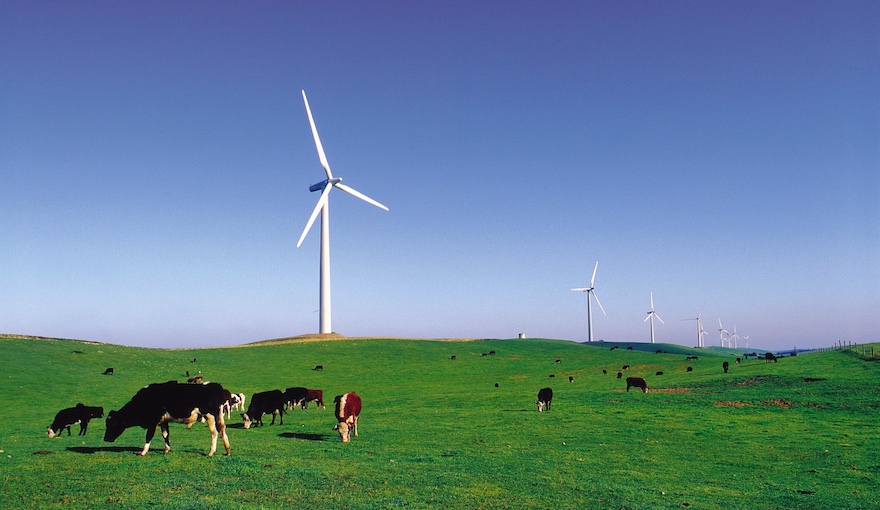Australia’s energy infrastructure czar wants governments to provide more clarity over who should bear the cost and the task of decommissioning wind and solar farms as they reach their end of life in coming decades.
The first wind farms in Australia are already approaching their use-by dates, and more wind and solar farms will reach the ends of their lives in the coming two decades, sparking concerns about who will pick up the tab of removing these assets if they are not “repowered” and have to be decommissioned.
Pacific Blue is the first on the east coast to endure the searing gaze of social expectations around decommissioning, as it removes the country’s first “commercial” scale wind project, the Codrington wind farm in Victoria (pictured above).
But as this becomes more common, renewables proponents and landowners may begin to discover potential flaws in the original agreements they signed.
The Australian Energy Infrastructure Commissioner, Tony Mahar, says there has to be more certainty and clarity around who pays, what measures are going to be in place and how much it will cost.
“It’s no secret that as this energy transition continues to progress, we should keep our eye on the future and prepare for the safe and sustainable end-of-life management of renewable energy infrastructure. For the most part the key concern here is how much and who pays,” Mahar said in a statement.
“The community needs more confidence that there will collaboration and rock-solid commitments that landholders won’t be left out of pocket if something goes wrong.”
The AEIC has released a new paper that calls for state planning authorities todevelop or revise mandatory model minimum requirements for end-of-life plans as part of regulatory conditions for new projects.
It also wants nationally consistent and legally enforceable mechanisms that will give landowners some financial security over costs.
And it wants a template for landowner agreements around how to handle end-of-life activities, and for end-of-life provisions and site rehabilitation to become part of the Developer Rating Scheme (DRS).
Mahar says these would improve landholder and community confidence in the industry generally, and in how decommissioning will be handled.
The AEIC says the oil and gas sector can offer some pointers as to what to do, and not do, as the renewables sector begins to wind down the first of its projects.
Already, a recycling industry set up to clean up offshore oil and gas components is underway that wind turbine owners in particular can lean into.
Decommissioning isn’t the only option for an end-of-life renewable energy project.
More years can be eked out with part replacements and careful maintenance, a project could be partly decommissioned, or a site can be repowered entirely, which involves putting a brand new, redesigned project – with all new approvals – on the site.
But as Pacific Blue said of Codrington, sometimes the cheapest or best option is to decommission.
Current rules not fit for purpose
The top issues worrying landowners and communities are who will be left to clean up at the end of who will pay for it.
Current rules and regulations do not offer a rock-solid guarantee that it won’t be the landowner.
Currently, decommissioning is guided by the agreement with the landowner and by the contents of the planning permit.
Legally-binding landowner agreements set out the expectations of how the project will be handled, but if that contradicts the planning permit, it’s not clear which would take precedent, the AEIC says.
And while decommissioning plans are now part of the planning approvals process, it doesn’t necessarily mean landowners are protected from the risk of being landed with the responsibility to handle the final clean up.
Plans can be “conditioned”, meaning the details don’t need to be worked out until the point of decommissioning, and the requirements can be attached to the land rather than the project owner.
The risk is that if a proponent abandons a project the property owner will have to carry out the permit requirements.
Landowners who didn’t have the right legal support when they signed an agreement in the early years of the industry would be better protected if governments could lead the creation of a landowner template and minimum decommissioning requirements for developers, the AEIC says.
Where is the money
But possibly the biggest worry for communities and landowners is what will happen if the project owner doesn’t have the cash set aside for the work, or goes bankrupt.
The AEIC is backing in an idea that is already being pitched by regional community groups to set up “a mechanism for providing financial surety”.
“There are different financial models that could be used, such as decommissioning bonds, trailing liabilities, pooled funds, and other insurance products,” it says.
“Ideally a nationally consistent approach should be agreed to that recognises state jurisdiction and regional context but also provides certainty and transparency for landholders and communities.”
Not trusting to promises is a view eloquently put by farmer and tax lawyer Claire Booth at the National Renewables in Agriculture Conference and Expo in Bendigo in July.
“Landowners should ensure that the [renewable energy development] company takes full responsibility for all operational risks … breaching of zoning or planning laws, and land rehabilitation at the end of the lease,” Booth told the conference.
“And I don’t trust any fucker. If you are saying to me that you are going to be rehabilitating my farm in 20 years, where is the money? Who holds it, and how do I know that it’s not been put in a term deposit and wasted away?”

Rachel Williamson is a science and business journalist, who focuses on climate change-related health and environmental issues.


